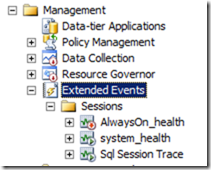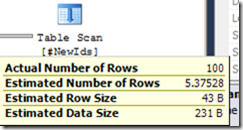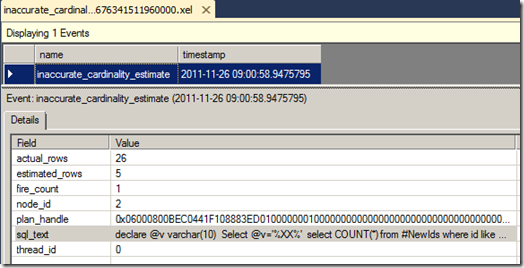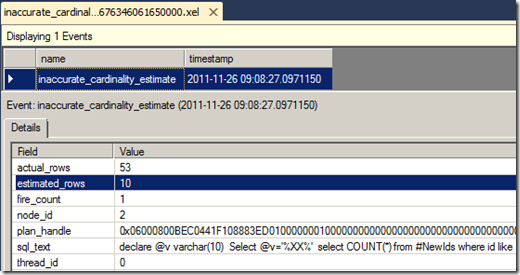Extended events have been a bit of a personal “Elephant in the room” for me. I know they are there and I should really get on a start using them but never *quite* have a compelling enough reason.
So now i really do, after comparing the events in sys.dm_xe_objects between 2008r2 and 2012 I found one that really peaked my interest, inaccurate_cardinality_estimate. This is described as “Occurs when an operator outputs significantly more rows than estimated by the Query Optimizer. Use this event to identify queries that may be using sub-optimal plans due to cardinality estimate inaccuracy. Using this event can have a significant performance overhead so it should only be used when troubleshooting or monitoring specific problems for brief periods of time.”
IMO cardinality estimation errors are the number one cause of performance problems. If sqlserver deduces ( or even guesses) an incorrect row estimation then all bets are off, if you get anything approaching a decent plan , its by luck not judgement.
So, lets see what if we can cause this event to fire. Firing up management studio, we have the new extended events manager,
which sounds like a fun tool to play with ![]() So starting a new session and going to the events library
So starting a new session and going to the events library
and filtering by ‘Card’
Oh , nothing found. Its simply not there , here is a connect item for this issue.
So , we will have to do this a more ‘manual’ way
CREATE EVENT SESSION inaccurate_cardinality_estimate ON SERVER
ADD EVENT sqlserver.inaccurate_cardinality_estimate
( ACTION (sqlserver.plan_handle, sqlserver.sql_text) )
ADD TARGET package0.asynchronous_file_target
( SET FILENAME = N'c:\temp\inaccurate_cardinality_estimate.xel',
metadatafile = N'c:\temp\inaccurate_cardinality_estimate.xem' );
Ok , session defined , lets start it.
ALTER EVENT SESSION inaccurate_cardinality_estimate ON SERVER STATE = START
To demonstrate the actual event we need to create and populate a temporary table :
drop table #newids
go
create table #NewIds
(
id char(36)
)
go
insert into #NewIds
select top(100)
cast(newid() as char(36))
from sys.all_columns a cross join sys.all_columns b
declare @v varchar(10)
Select @v='%XX%'
select COUNT(*) from #NewIds where id like @v
update
#NewIds
set id = 'XX'+left(id,20)
declare @v varchar(10)
Select @v='%XX%'
select COUNT(*) from #NewIds where id like @v
ALTER EVENT SESSION inaccurate_cardinality_estimate ON SERVER STATE = STOP
There is the event, nice. But hold on one cotton picking minute, look at the row counts. Estimated = 5 , actual = 26 !?!
What happens if we repeat this operation but doubling the rows in the temp table
If we double the amount of rows in our temp table to 200, our estimate rows in the plan will show as 10.7506 and actual as 200. In the extended event we see :
So the estimated count is shown as floor(row estimate) and the event is fired when the actual row count goes over 5*plan estimate, which is why actual is shown here as 53 not 200. Notice that we also have the plan_handle and the node_id if we wish to tie this back to an exact operator in our system.
Quite why this is an extended event and not a plan warning , i really have no idea, still its nice to know its there.








